by Christian Perez
Christian continues his series on Philippine bird books. In this third installment, he focuses on Philippine endemics.
Introduction
After reviewing the pioneering work of ornithologists in the 18th century, which was marked by the introduction of modern taxonomy to classify and name living beings, we will now review the explorations of the 19th century, an era of scientific discovery and invention, and of easier travel around the world. After a quiet period during its first 20 years, the 19th century will see an explosion of publications regarding Philippine birds, mostly as papers and articles in scientific journals. This Part 3 covers the period from the early 1820s to the late 1860s, a decade that will see the publication of the first list of all known Philippine birds. I will focus on Philippine endemics and try to cover all writings where new endemic species were described and named, and those where they were illustrated. Most publications mentioned in this article are accessible online by clicking on the name, normally opening on the page where the bird is mentioned.
1. Vieillot : Gallerie des Oiseaux (1822)
Louis Vieillot (1748–1831) was a French ornithologist. He published several ornithology books between 1805 and 1830 including a new edition of Bonnaterre’s Ornithologie in 1823 and La Galerie des Oiseaux (Gallery of Birds) in Paris in 1822-25.
Vieillot is credited for providing the scientific name of the Writhed Hornbilll in 1816 in Nouveau Dictionnaire d’Histoire Naturelle (page 592), with the following introduction: “This bird that Mr.Temminck keeps in his rich and vast collection has not yet been described.” Vieillot also named the Blue-crowned Racket-tail in Galerie des Oiseaux in 1822 (page 7 – the link is to a later 1834 edition), where he states that: “This species, a specimen of which can be seen at the Natural History Museum, is found in Mindanao.”

2. Vigors: Proceedings of the Zoological Society (1831)
Nicholas Vigors (1785-1840) was an Irish zoologist and politician. He was a co-founder of the Zoological Society of London in 1826, and its first secretary until 1833. The 1830-31 issue of the Proceedings of the Zoological Society includes a paper by Vigors entitled “On a Collection of Birds from Manilla, presented by H. H. Lindsay, Esq. with Characters of New Species” (page 96).
Vigors writes: “A collection of Birds presented to the Society by H. H. Lindsay, Esq. of Canton, were laid upon the table. They were accompanied by a letter from that gentleman to the Secretary, of the date of Jan. 25, 1831, stating that the collection had been formed during the summer of the previous year in the neighbourhood of Manilla, and adding some notes respecting the various species, as well as the names in the Tagallo or native language of the country. The collection consisted of about fifty-six species, fifty of which at least had not previously been in the Society’s Museum, or in any other public collection in England.” Vigors goes on to describe in Latin the following species collected by Lindsay: Philippine Falconet, Philippine Serpent-Eagle, Great-eared Nightjar, Spotted Wood-Kingfisher, Black-naped Monarch, Philippine Pied Fantail, Philippine Fairy-Bluebird, Colasisi, Luzon Flameback, Sooty Woodpecker, Violet Cuckoo, and Rufous Night-Heron.
Vigors provided the binomial name for the following endemic species in that paper: Philippine Falconet, Spotted Wood Kingfisher, Philippine Pied Fantail, Philippine Fairy-bluebird, and Philippine Serpent Eagle. Like almost all authors of the 19th century, Vigors does not use common English names in his writings, so the reader needs to be familiar with scientific names.
Hugh Lindsay (1802-1881) was an English naturalist and collector. He was an employee of the British East India Company and visited Manila during a posting in China. The Spotted Wood Kingfisher was named after him by Vigors and is now known as Actenoides lindsayi Vigors 1831.

3. Meyen: Novorum Actorum (1834)
The Plain Bush-hen Amaurornis olivacea Meyen 1834 was described and named by Prussian botanist Franz Meyen in Novorum Actorum, Bonn and Wroclaw, 1834 (page 109). The description was accompanied with an illustration of rather doubtful quality. Meyen took part in an expedition around the world on board the Prinzess Luise in 1830-1832 that visited Asia and South America, and stopped briefly in Manila. About the Plain Bush-hen, Meyen writes: “Locality (Vaterland): Manila, near the sea shore”.
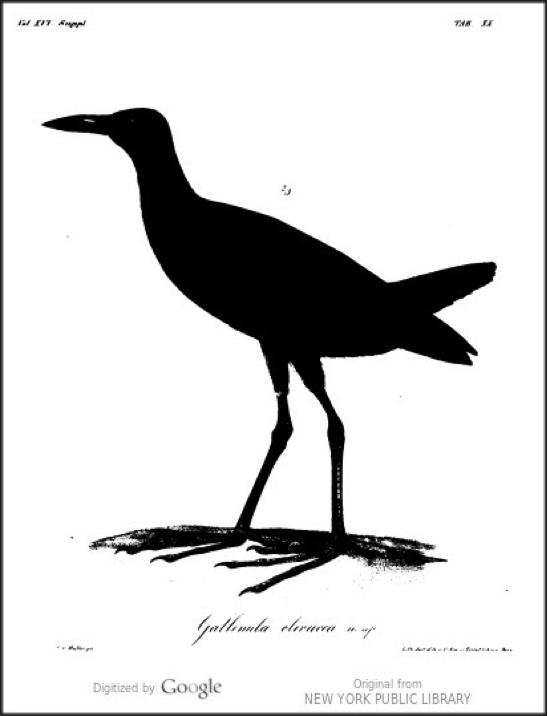
4. Kittlitz: Vögel von der Insel Luzon (1835)
Heinrich von Kittlitz (1799–1874) was a German explorer and naturalist. He sailed round the world between 1826 and 1829 on the Russian corvette the Semarine under Captain Lütke. He was in Manila in January 1829 where he gathered new species of birds that he described in “Über einige noch unbeschriebene Vögel von der Insel Luzon, den Carolinen und den Marianen” (About some still undescribed birds from Luzon, the Carolines and the Mariannes), a paper that was published in “Mémoires présentés à l’Académie Impériale des Sciences de Saint-Pétersbourg” in St Petersburg, Russia in 1835.
The Philippine birds described and illustrated are Philippine Falconet, Pygmy Flowerpecker, Lowland White-eye, Philippine Pied Fantail and White-browed Shama. Kittlitz is credited for providing the scientific names of White-browed Shama and Pygmy Flowerpecker.
Kittlitz actually observed birds in the wild and is the first author to describe their behavior and habitat in addition to their physical features. His illustrations appear to have been sketched in the field rather than from dead skins, although he was also a hunter. Here is what he writes about his observation of the White-browed Shama: “It is difficult to immediately identify these small birds, particular when one, like me, does not know anything about their habit and pose, because I only have a single specimen given to me already shot. I was finally convinced, however, that the long known Turdus macrourus L. from the East Indies is certainly of a closely related species, and that we should not separate one from the other. […] The present bird was shot in a dense bush along the bank of a creek.”
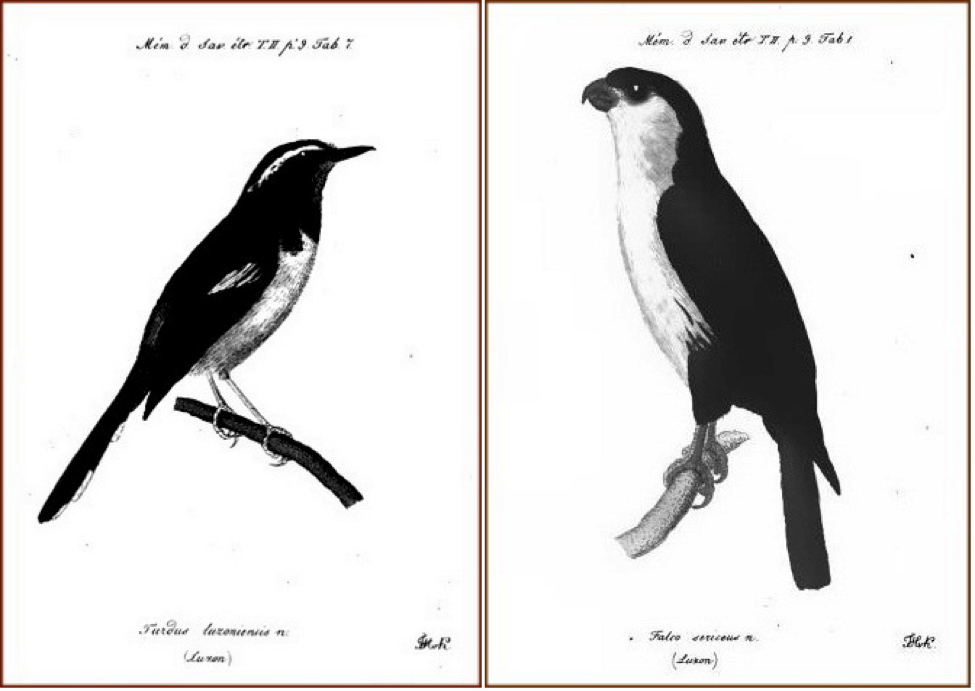

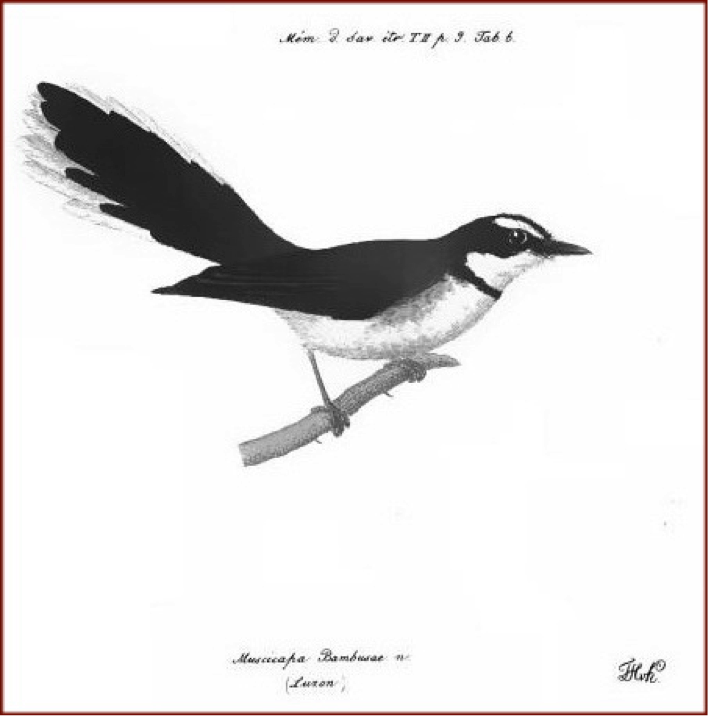
5. Temminck : Nouveau recueil de planches coloriées d’oiseaux (1838)
Coenraad Temminck (1778–1858) was a Dutch zoologist and the director of the National Natural History Museum at Leiden, Netherlands from 1820 until his death. He inherited a large collection of bird specimens from his father, who was treasurer of the Dutch East India Company. He wrote many books on birds including Nouveau recueil de planches coloriées d’oiseaux (New Collection of Colored Bird Plates) in Paris from 1820 to1839, which is presented as a supplement to Buffon’s Histoire Naturelle des Oiseaux. The Temminck’s Stint Calidris temminckii Leister 1812 was named after him. Temminck is credited for naming 32 of the 672 birds in the WBCP checklist, including the endemics Palawan Peacock-Pheasant, White-eared Brown Dove, Philippine Trogon and Stripe-headed Rhabdornis.
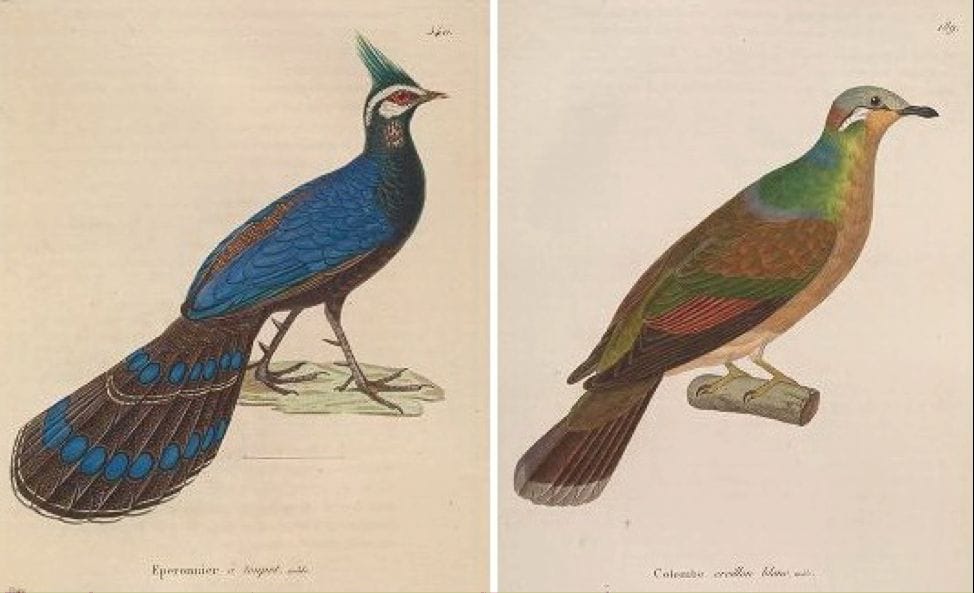
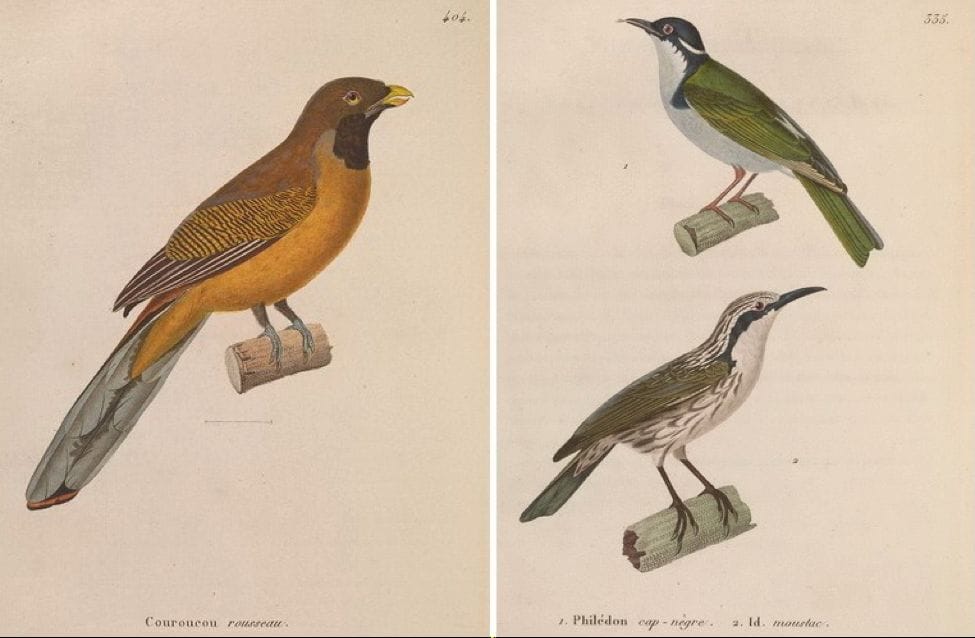

6. Gray: The Genera of Birds (1849)
George Robert Gray (1808–1872) was an English zoologist and the head of the ornithological section of the British Museum, now the Natural History Museum, for 41 years. His most important publication was The Genera of Birds (London, 1844–49) which included 46,000 references. He described and named Gray’s Grasshopper Warbler Locustella fasciolata Gray 1860 from a specimen collected by British naturalist Alfred Wallace. Gray is credited for naming the Yellow-breasted Fruit Dove, Pink-bellied Imperial Pigeon and Pygmy Swiftlet. The only descriptions he provided for these three birds were the beautiful illustrations below.


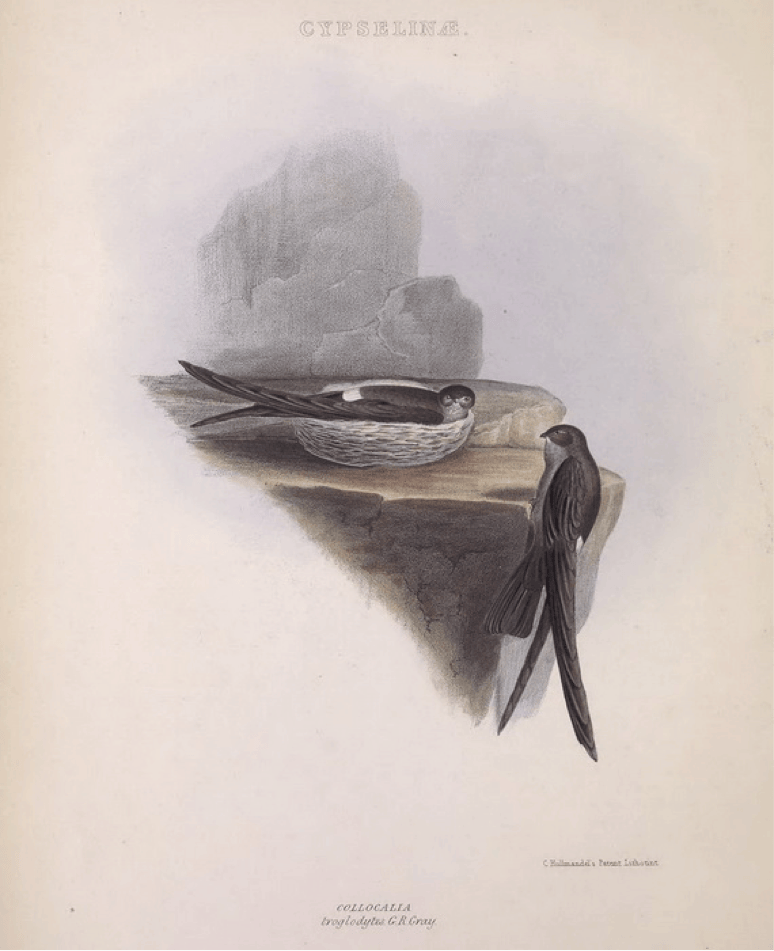
7. Bonaparte: Conspectus Generum Avium (1850)
Charles Lucien Bonaparte (1803–1857), was a French biologist and ornithologist, and a nephew of Emperor Napoleon. He was raised in Italy, lived in the United States, then in Italy and in England before returning to France in 1850. On that year he published the first volume of his Conspectus Generum Avium in Leiden, Netherlands, where he described and named the Amethyst Brown Dove, Philippine Green Pigeon, Blue-capped Wood Kingfisher, and Lowland White-eye. This is a rather austere book written in Latin without illustrations, but many new birds were named and it became a useful reference at the time.

The Philippine Cuckoo-Dove was described and named by Bonaparte in Comptes Rendus des Séances de l’Académie des Sciences, Paris, 1854 (vol 39 page 1111), where he writes: “Macropygia tenuirostris is a distinct species, peculiar to the Philippines, separated by its small bill and the length of the middle finger; it is smaller and more reddish than the previous ones”; and the Spotted Imperial Pigeon Ducula carola in the same periodical (vol 39 page 1075), where he informs the reader that: “I dedicate it to my daughter the Countess Primoli, Charlotte (Carola) Bonaparte, worthy of a name that is already illustrious in the family”. He also named the Black-chinned Fruit Dove (vol. 41 page 247) and the Luzon Hawk-Owl (vol 41 page 655) in 1855.
8. Hombron and Jaquinot: Voyage au Pôle Sud et dans l’Océanie (1853)
Jacques Hombron and Honoré Jacquinot were naturalists on board the French corvettes L’Astrolabe and La Zélée that travelled around the world in 1837-1840 under Captain Dumont d’Urville and stopped in Zamboanga in June and July 1837. They published “Voyage au Pôle Sud et dans l’Océanie” (Travel to the South Pole and Oceania) in Paris in 1853, where they described two birds they had observed in Zamboanga: Mindanao Bleeding-Heart Gallicolumba crinigera Pucheran 1853, named by French zoologist on board Jacques Pucheran (1817-1895); and Blue-capped Wood Kingfisher (or Hombron’s Kingfisher) Actenoides hombroni that had been named by Bonaparte after Hombron in 1850 (see p101 and 118).
This is what Hombron writes about the Blue-capped Wood Kingfisher: “Actenoides hombroni is from Mindanao (Zamboanga). We think, like Bonaparte, that it is genetically related to Dacelo Lindsayi Vigors [Spotted Wood Kingfisher]. But it differs with its larger bill, blue on the head and tail, etc. It is therefore a new fact that we can add to what we already know in ornithology, and that establishes that, like the Sandwich Islands and New Zealand, the Philippines contains its own peculiar genera”. The English word ‘endemic’ was not yet used by ornithologists. They often used the word ‘peculiar’ instead, so I used that word in my translation.
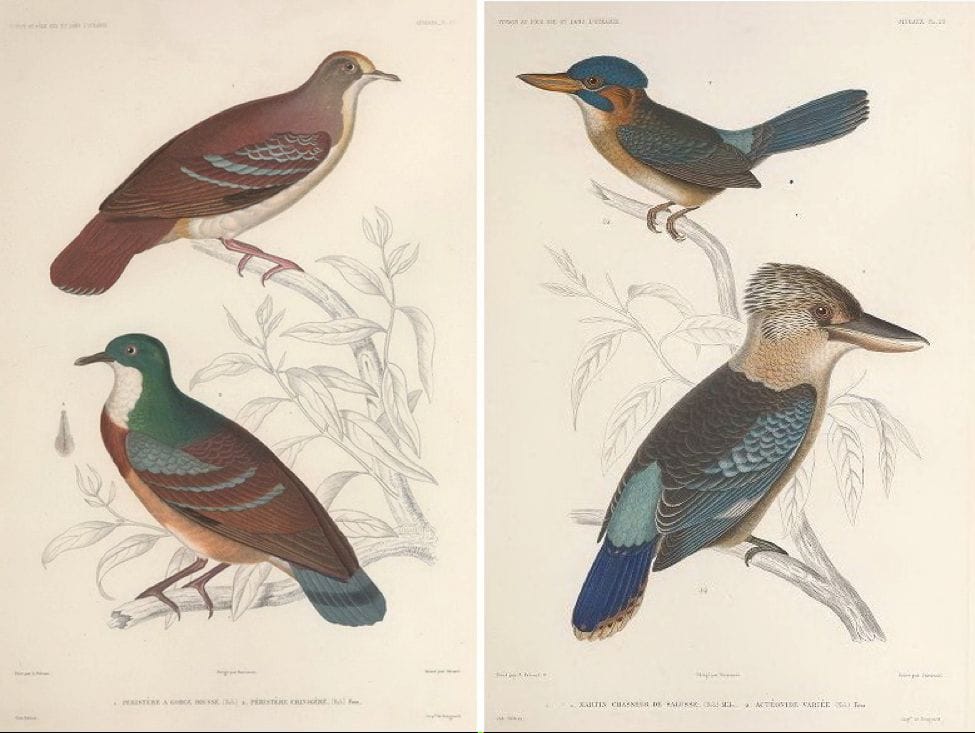
Another French corvette called La Bonite sailed around the world in 1836-1837 and stopped in Manila in 1837. The naturalists on board, Joseph Eydoux and Louis Souleyet, observed Philippine Falconet, Scale-feathered Malkoha and Spotted Wood Kingfisher and described them in “Voyage autour du monde exécuté pendant les années 1836 et 1837 sur la corvette la Bonite” (Travel around the world in 1838-37 on board La Bonite) published in Paris in 1841.
9. Moore: Proceedings of the Zoological Society of London (1854)
The Grey-backed Tailorbird Orthotomus derbianus Moore 1854 was described, named and illustrated by British entomologist Frederic Moore (1830-1907) in Proceedings of the Zoological Society of London (PZS) in 1854 from a specimen found in the Derby Museum in Liverpool that had been collected by English naturalist Hugh Cuming.
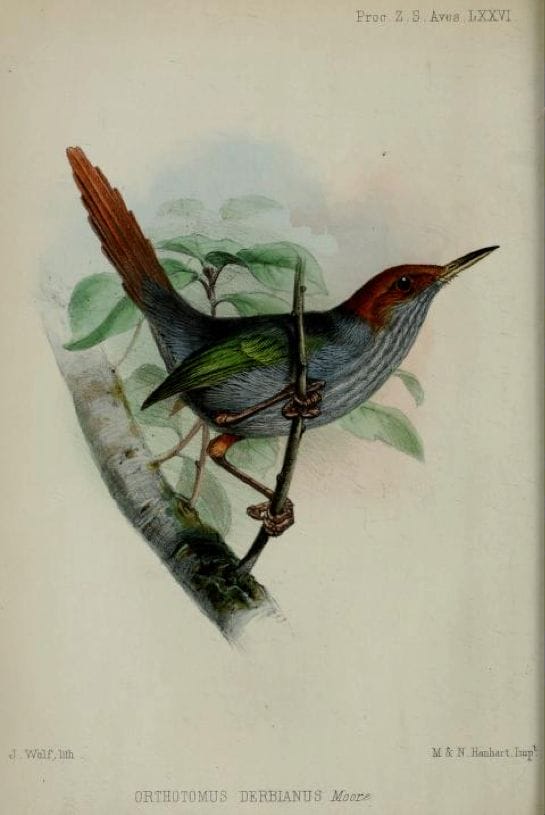
10. Cassin: Proceedings of the Academy of Natural Sciences of Philadelphia (1854)
 American ornithologist John Cassin was curator of the Philadelphia Academy of Natural Sciences. He described and named the Grey Imperial Pigeon Ducula pickeringii and Blue-headed Fantail Rhipidura cyaniceps in Proceedings of the Academy of Natural Sciences of Philadelphia in 1854 and 1855, pages 228 and 438. These are the first Philippine birds named by an American. The skins were collected during the U.S. Exploring Expedition of 1839-1842. Cassin writes about the Grey Imperial Pigeon: “I dedicate this bird, as a slight testimony of respect, to Charles Pickering, M. D., one of the Naturalists of the Exploring Expedition, who, in addition to the materials for his valuable volumes, has, in his manuscript notes, now in my possession, made important contributions to Ornithology.” Both birds were later illustrated by Cassin in the “Atlas of the U. S. Exploring Expedition under the command of Charles Wilkes”, Philadelphia, 1868.
American ornithologist John Cassin was curator of the Philadelphia Academy of Natural Sciences. He described and named the Grey Imperial Pigeon Ducula pickeringii and Blue-headed Fantail Rhipidura cyaniceps in Proceedings of the Academy of Natural Sciences of Philadelphia in 1854 and 1855, pages 228 and 438. These are the first Philippine birds named by an American. The skins were collected during the U.S. Exploring Expedition of 1839-1842. Cassin writes about the Grey Imperial Pigeon: “I dedicate this bird, as a slight testimony of respect, to Charles Pickering, M. D., one of the Naturalists of the Exploring Expedition, who, in addition to the materials for his valuable volumes, has, in his manuscript notes, now in my possession, made important contributions to Ornithology.” Both birds were later illustrated by Cassin in the “Atlas of the U. S. Exploring Expedition under the command of Charles Wilkes”, Philadelphia, 1868.
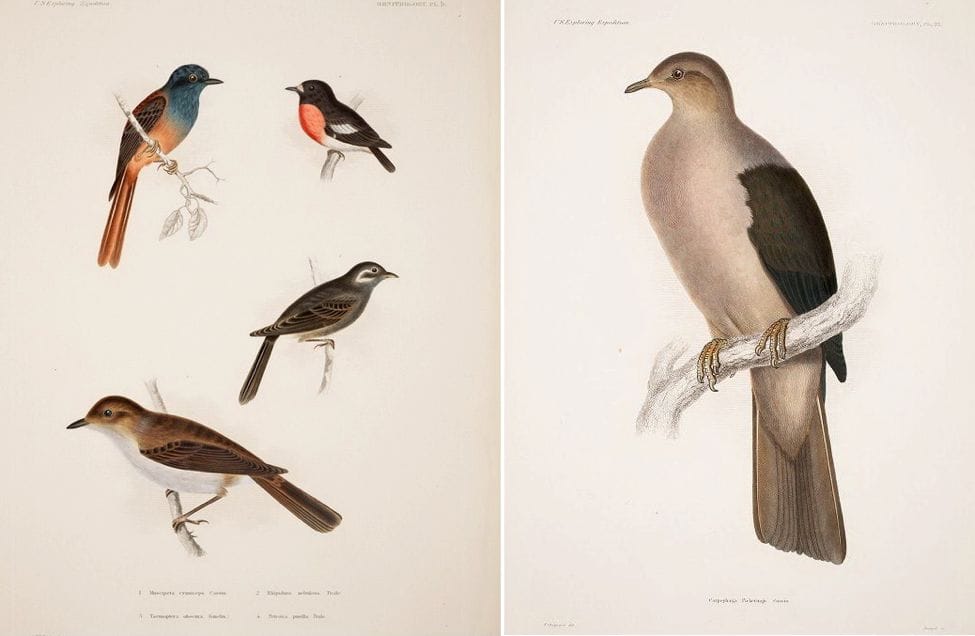
11. Jardine: The Natural History of Nectariniadae or Sun-birds (1864)
William Jardine (1800-1874) was a Scottish naturalist. He published many books including “The Natural History of Nectariniadae or Sun-birds” (London, 1864) with pretty Sunbird illustrations. Jardine is credited for naming the Copper-throated Sunbird Leptocoma calcostetha Jardine 1843.

12. Other Philippine endemics first named during the period
To be complete and for reference, here is a list of publications where other Philippine endemics or near endemics were named during the period
The Rough-crested Malhoha Dasylophus superciliosus Dumont 1823 was named by French naturalist Charles Dumont de Sainte-Croix in Dictionnaire des Sciences Naturelles volume 28 (Strasbourg, France, 1823), page 451, where he writes: “This Philippine bird, two specimens of which given by Mr. Dussumier are found in the Natural History Museum in Paris, is smaller than the European Cuckoo, but it has its long and thin tail…”
The Sooty Woodpecker Mulleripicus funebris Valenciennes 1826 was named by French Zoologist Achille Valenciennes in Dictionnaire des Sciences Naturelles volume 40 (Strasbourg, France, 1826), page 179.
The Luzon Flameback Chrysocolaptes haematribon Wagler 1827 was named by German zoologist Johann Wagler in Systema Avium (Stuttgart, 1827), page 46, number 95.
The Black-faced Coucal Centropus melanops Lesson 1830 and Elegant Tit Periparus elegans Lesson 1831 were named by French ornithologist René Lesson in Traité d’Ornithologie (Paris, 1831), page 137 and 456, with the Black-faced Coucal erroneously located in Java and no location given for the Elegant Tit.
The Philippine Duck Anas luzonica Fraser 1839 and Scale-feathered Malkoha Dasylophus cumingi Fraser 1839 were named by British zoologist Louis Fraser in the Proceedings of the Zoological Society (London, 1839) page 112-3 from skins that had been gathered in “the south part of Luzon” by English collector Hugh Cuming during his stay in the Philippines in 1836-1839.
This is an extract from the proceedings: “Mr. Fraser read his descriptions of two new species of birds, from a collection made in the Island of Luzon, and recently forwarded to the Society by Hugh Cuming, Esq., Corresponding Member. … This beautiful and interesting species Mr. Fraser proposed to name after its discoverer Mr. Cuming.”
The Indigo-banded Kingfisher Ceyx cyanopectus Lafresnaye 1840 was named by French ornithologist and collector Nöel de Lafresnaye in Revue Zoologique (Paris, 1840), page 33.
The Blackish Cuckooshrike Coracina coerulescens Blyth 1842 and the Black-and-white Triller Lalage melanoleuca Blyth 1861 were named by English ornithologist Edward Blyth in Journal of Asiatic Society volume 11 (Calcutta, 1842), page 463, and in volume 30 (Calcutta 1861), page 97.
The Philippine Dwarf Kingfisher Ceyx melanurus Kaup 1848 was named by German naturalist Johann Kaup in Verhandlungen des Naturhistorischen (Proceedings of Natural History), Hessen, Germany, 1848; and the Philippine Eagle Owl Bubo philippensis Kaup 1851 in Archiv für Naturgeschichte, Berlin, 1851.
The Philippine Hawk-Cuckoo Hierococcyx pectoralis Cabanis & Heine 1862 and Rufous Coucal Centropus unirufus Cabanis & Heine 1863 were named by German ornithologists Jean Cabanis and Ferdinand Heine in Museum Heineanum, 1863 (not found online).
13. Martens: Survey of known Philippine birds (1866)
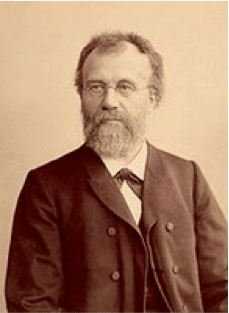 Eduard von Martens (1831–1904) was a German zoologist. In 1860 he embarked on an expedition to East Asia and visited Manila in May 1861, where he studied the bird specimens in the collection of the Biblioteca Militar. He was a foreign member of the Linnaean Society of London, and a corresponding member of the Zoological Society of London. He published Zusammenstellung der bekannten philippinischen Vögel (Survey of known Philippine birds) in the 1866 issue of Journal für Ornithologie published in Kassel, Germany, pages 5-31. This was the first attempt to compile a complete list of all known Philippine birds.
Eduard von Martens (1831–1904) was a German zoologist. In 1860 he embarked on an expedition to East Asia and visited Manila in May 1861, where he studied the bird specimens in the collection of the Biblioteca Militar. He was a foreign member of the Linnaean Society of London, and a corresponding member of the Zoological Society of London. He published Zusammenstellung der bekannten philippinischen Vögel (Survey of known Philippine birds) in the 1866 issue of Journal für Ornithologie published in Kassel, Germany, pages 5-31. This was the first attempt to compile a complete list of all known Philippine birds.
Martens listed a total of 194 species but I was only able to confirm 159 species. The rest could not be identified with certainty, did not occur in the Philippines, or duplicated other species in the list (Walden 1875). Nine endemic species that had already been described before 1866 are missing from Martens’ list, such as the Palawan Peacock-Pheasant (Temminck 1831), Mindanao Bleeding-Heart (Pucheran 1853), Blue-headed Fantail (Cassin 1855) and Grey-backed Tailorbird (Moore 1854).
Surprisingly, some species that are common today are missing: Yellow Bittern, Whiskered Tern, Spotted Dove, Lesser Coucal, Glossy Switflet, Striated Grassbird and Zitting Cisticola. A few birds that are rare today had already been recorded: Cotton Pygmy Goose, Streaked Shearwater, Eurasian Spoonbill, Oriental Hobby, Malayan Night Heron, Island Collar Dove and Pale Thrush. A few birds were reported around Manila but are no longer seen today: Spot-billed Pelican, Sarus Crane (Martens lists a Grus sp.), Oriental Darter and Philippine Cockatoo. Two introduced birds are in the list: Crested Myna and Java Sparrow.

Conclusion
The authors of the 19th century did not use common names. To read and understand their writings requires familiarity with scientific names, or constant reference to indices of scientific names. They sometimes use species names that are synonyms of the currently accepted names, or names that have not been accepted and are no longer in use. In most cases the genus names they use have since changed due to taxonomic rearrangements. To relate the birds they describe to the currently known species can be a challenge.
Although no book was solely dedicated to Philippine birds during the period, we have seen that there was a plethora of articles and papers related to Philippine ornithology. Of the 245 Philippine endemic or near endemic species in the WBCP 2013 Checklist, 46 were formally named during the period (from 1816 to 1870), which brings the total to 64 species as of 1870. In 1870 the total number of bird species known to occur in the Philippines including residents and migrants can be estimated to be around 170 based on the corrected and adjusted 1866 Martens list. Most of them were collected in the vicinity of Manila, with only a handful of species from Panay, Palawan and Zamboanga, all in the lowlands. The last decades of the century would witness the exploration of the remaining Philippine islands and the highlands, and an acceleration of ornithological discoveries in the country, as we will see in the next part of this article.
To be continued
Links to previous articles in the series:

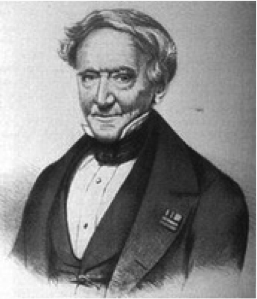
Pingback:A Short History of Philippine Bird Books – Part 4 The 1870s | e-BON
Pingback:A Short History of Philippine Bird Books – Part 5 1881 to 1899 | e-BON
Pingback:A Short History of Philippine Bird Books – Part 6 American Period | e-BON
Pingback:A Short History of Philippine Bird Books – Part 7 1946 to 2000 | e-BON